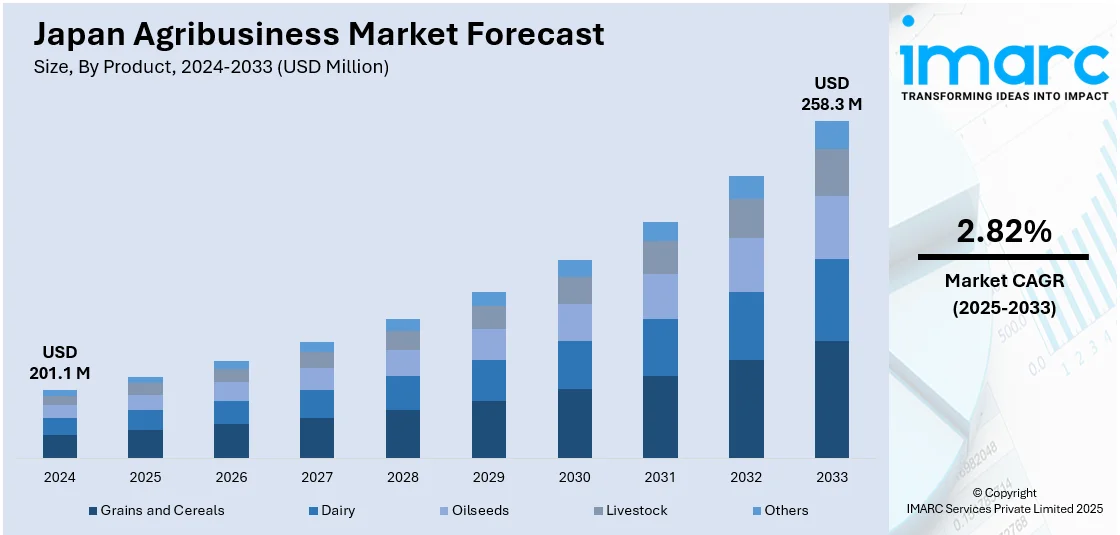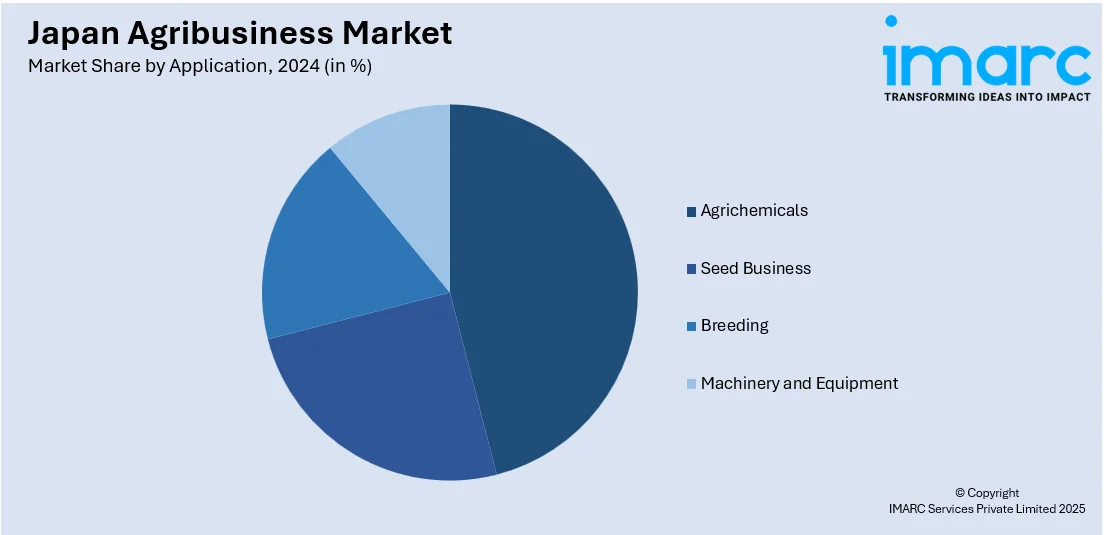
Japan Agribusiness Market Size, Share, Trends and Forecast by Product, Application, and Region, 2025-2033
Japan Agribusiness Market Overview:
The Japan agribusiness market size reached USD 201.1 Million in 2024. Looking forward, IMARC Group expects the market to reach USD 258.3 Million by 2033, exhibiting a growth rate (CAGR) of 2.82% during 2025-2033. The market is driven by rising demand for food security, ongoing technological advancements in smart farming, increasing government subsidies, shifting consumer preferences toward organic produce, labor shortages, surging automation, expanding exports, and climate change adaptation efforts.
|
Report Attribute
|
Key Statistics
|
|---|---|
|
Base Year
|
2024
|
|
Forecast Years
|
2025-2033
|
|
Historical Years
|
2019-2024
|
| Market Size in 2024 | USD 201.1 Million |
| Market Forecast in 2033 | USD 258.3 Million |
| Market Growth Rate 2025-2033 | 2.82% |
Japan Agribusiness Market Trends:
Adoption of Smart and Precision Farming Technologies
The Japan agribusiness industry is adopting smart and precision farming technology as it addresses employee shortages while achieving increased operational efficiency. The necessity of automation alongside artificial intelligence (AI)-driven solutions has become vital because Japan faces a reduced agricultural workforce and an aging farming population. Moreover, modern agricultural technologies, including autonomous tractors alongside drone monitoring and Internet of Things (IoT) greenhouses, assist farmers in enhancing their productivity and decreasing resource utilization. Japanese officials also support smart farming growth by offering funding support as well as research programs that guide farmers to combine data analytics solutions and robotic technology in their agricultural operations. For example, in October 2024, NX Group invested in AGRIST, a developer of AI- and robot-driven smart agriculture technology, to address challenges in agri-food systems both in Japan and globally. Furthermore, the growing interest in urban farming systems combines vertical farming with hydroponics methods because they suit limited urban property requirements. Digital transformation serving agribusinesses functions as their foundation for enhancing productivity and achieving sustainable future success. As a result, the development of AI, along with machine learning (ML) technologies in agriculture, is significantly driving the Japan agribusiness market growth.

Growth of Sustainable and Organic Agriculture
The Japanese consumer market shows a strong upward trend in demand for sustainable and organic agricultural produce because people increasingly care about health, environmental issues, and food safety. This trend is boosting the Japan agribusiness market share. In addition to this, the clean-label movement and consumer preference for pesticide-free food have created an increase in organic farming activities. Japanese government agencies work through the Green Food System Strategy to combine efforts for chemical pesticide and fertilizer reduction with programs that build carbon-neutral farming methods. For instance, in November 2024, the Japan International Cooperation Agency (JICA) announced a new climate strategy for agricultural and rural development cooperation, focusing on building climate resilience and promoting sustainable practices in developing nations. The Japanese consumer base also shows an increasing interest in regenerative agriculture because it improves soil health as well as ecological diversity. Concurrently, sustainability objectives receive additional support from eco-friendly packaging developments and waste reduction initiatives. Large businesses involved in retail and food manufacturing are also using locally produced organic ingredients to serve evolving market demands. Agribusiness operators are further dedicating greater capital towards sustainable production and distribution methods because sustainability has become a fundamental business priority. As a result, the Japanese market for organic food continues to grow through exports, which focus on sending organic produce to Europe along North America, which is enhancing the Japan agribusiness market outlook.
Japan Agribusiness Market Segmentation:
IMARC Group provides an analysis of the key trends in each segment of the market, along with forecasts at the region level for 2025-2033. Our report has categorized the market based on product and application.
Product Insights:
- Grains and Cereals
- Dairy
- Oilseed
- Livestock
- Others
The report has provided a detailed breakup and analysis of the market based on the product. This includes grains and cereals, dairy, oilseed, livestock, and others.
Application Insights:

- Agrichemicals
- Seed Business
- Breeding
- Machinery and Equipment
A detailed breakup and analysis of the market based on the application have also been provided in the report. This includes agrichemicals, seed business, breeding, and machinery and equipment.
Regional Insights:
- Kanto Region
- Kansai/Kinki Region
- Central/Chubu Region
- Kyushu-Okinawa Region
- Tohoku Region
- Chugoku Region
- Hokkaido Region
- Shikoku Region
The report has also provided a comprehensive analysis of all the major regional markets, which include Kanto, Kansai/Kinki, Central/Chubu, Kyushu-Okinawa, Tohoku, Chugoku, Hokkaido, and Shikoku regions.
Competitive Landscape:
The market research report has also provided a comprehensive analysis of the competitive landscape. Competitive analysis such as market structure, key player positioning, top winning strategies, competitive dashboard, and company evaluation quadrant has been covered in the report. Also, detailed profiles of all major companies have been provided.
Japan Agribusiness Market News:
- In March 2024, the Japanese government announced plans to promote smart agriculture by enhancing industry-academia-government collaboration centers and supporting startups to boost productivity and sustainability in the agricultural sector.
- In August 2023, Meiji Group joined the Doto Carbon Farming Study Group to promote carbon farming in Hokkaido, collaborating with dairy farmers to reduce emissions and enhance soil quality, driving Japan’s sustainable agribusiness growth.
Japan Agribusiness Market Report Coverage:
| Report Features | Details |
|---|---|
| Base Year of the Analysis | 2024 |
| Historical Period | 2019-2024 |
| Forecast Period | 2025-2033 |
| Units | Million USD |
| Scope of the Report |
Exploration of Historical Trends and Market Outlook, Industry Catalysts and Challenges, Segment-Wise Historical and Future Market Assessment:
|
| Products Covered | Grains and Cereals, Dairy, Oilseed, Livestock, Others |
| Applications Covered | Agrichemicals, Seed Business, Breeding, Machinery and Equipment |
| Regions Covered | Kanto Region, Kansai/Kinki Region, Central/Chubu Region, Kyushu-Okinawa Region, Tohoku Region, Chugoku Region, Hokkaido Region, Shikoku Region |
| Customization Scope | 10% Free Customization |
| Post-Sale Analyst Support | 10-12 Weeks |
| Delivery Format | PDF and Excel through Email (We can also provide the editable version of the report in PPT/Word format on special request) |
Key Questions Answered in This Report:
- How has the Japan agribusiness market performed so far and how will it perform in the coming years?
- What is the breakup of the Japan agribusiness market on the basis of product?
- What is the breakup of the Japan agribusiness market on the basis of application?
- What is the breakup of the Japan agribusiness market on the basis of region?
- What are the various stages in the value chain of the Japan agribusiness market?
- What are the key driving factors and challenges in the Japan agribusiness?
- What is the structure of the Japan agribusiness market and who are the key players?
- What is the degree of competition in the Japan agribusiness market?
Key Benefits for Stakeholders:
- IMARC’s industry report offers a comprehensive quantitative analysis of various market segments, historical and current market trends, market forecasts, and dynamics of the Japan agribusiness market from 2019-2033.
- The research report provides the latest information on the market drivers, challenges, and opportunities in the Japan agribusiness market.
- Porter's five forces analysis assist stakeholders in assessing the impact of new entrants, competitive rivalry, supplier power, buyer power, and the threat of substitution. It helps stakeholders to analyze the level of competition within the Japan agribusiness industry and its attractiveness.
- Competitive landscape allows stakeholders to understand their competitive environment and provides an insight into the current positions of key players in the market.
Need more help?
- Speak to our experienced analysts for insights on the current market scenarios.
- Include additional segments and countries to customize the report as per your requirement.
- Gain an unparalleled competitive advantage in your domain by understanding how to utilize the report and positively impacting your operations and revenue.
- For further assistance, please connect with our analysts.
 Request Customization
Request Customization
 Speak to an Analyst
Speak to an Analyst
 Request Brochure
Request Brochure
 Inquire Before Buying
Inquire Before Buying




.webp)




.webp)












